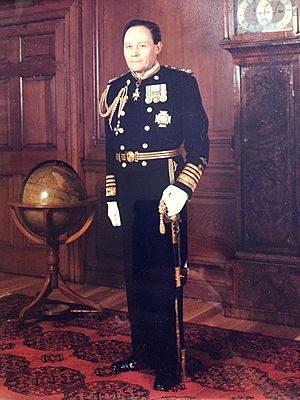Brian Brown (Royal Navy officer) facts for kids
Quick facts for kids
Sir Brian Brown
|
|
|---|---|

Sir Brian Brown
|
|
| Born | 31 August 1934 |
| Died | 27 April 2020 (aged 85) |
| Allegiance | United Kingdom |
| Service/ |
Royal Navy |
| Years of service | 1952–1991 |
| Rank | Admiral |
| Commands held | HMS Raleigh |
| Battles/wars | Korean War |
| Awards | Knight Commander of the Order of the Bath Commander of the Order of the British Empire |
Admiral Sir Brian Thomas Brown (31 August 1934 – 27 April 2020) was a very important officer in the Royal Navy. He held a top position as the Second Sea Lord and Chief of Naval Personnel from 1988 to 1991. This role meant he was in charge of all the people in the Navy.
Contents
Brian Brown was born in Portsmouth and went to Peter Symonds' School. He joined the Royal Navy on 1 May 1952. He started his training at the Britannia Royal Naval College in Dartmouth. He was part of the Supply and Secretariat branch, which means he helped manage supplies and paperwork for the Navy.
During his training, he sailed on ships like HMS Devonshire and HMS Unicorn. He even served during the Korean War. He was promoted to midshipman (a junior officer rank) in 1953. After more training, he became a sub-lieutenant in 1955. He then joined the ship HMS Kenya as a supply officer. He was promoted to lieutenant in 1956.
At one point, the Navy needed more pilots. So, some supply officers, including Brian, were chosen for flying training. This was quite unusual at the time!
He started his basic flying training in June 1957. He learned to fly on planes like the Provost and Vampire. He earned his Fleet Air Arm pilot's wings on 11 July 1958. After this, he trained on Sea Hawks at HMS Fulmar.
His first flying job was with 898 Naval Air Squadron in December 1958. This squadron flew Sea Hawk jets for ground attacks. He sailed with them on the aircraft carrier HMS Eagle in the Mediterranean Sea.
To keep flying, Brian volunteered for helicopter training. He learned to fly Hiller and Whirlwind helicopters. In 1960, he joined 848 Naval Air Squadron, a commando helicopter squadron. He served on HMS Bulwark, which was the Royal Navy's first ship designed to carry Royal Marines commandos. He took part in important operations like the Kuwait Crisis in 1961. He also flew missions to support Army units fighting in Malaysia.
In October 1961, Brian returned to his regular supply duties. He worked on ships like HMS Narvik and at naval bases in Malta. He helped plan how to reduce the size of the Malta Naval Base.
He was promoted to lieutenant commander in 1964. He then worked at the Ministry of Defence in London. He was an assistant to the First Sea Lord, who is the head of the Royal Navy. After this, he had a special job on HM Yacht Britannia, the Queen's Royal Yacht. He was the deputy supply officer there for over two years.
In 1969, he was promoted to commander. He worked as a secretary to the Flag Officer, Carriers and Amphibious Ships. Later, he returned to the Ministry of Defence to help plan for naval officers' training.
In 1973, Brian became the supply officer for the helicopter cruiser HMS Tiger. He also sometimes flew as a second pilot in Sea King helicopters from the ship.
High-Ranking Roles
In 1975, Brian was promoted to captain. He became the secretary to the Vice Chief of the Naval Staff at the Ministry of Defence. He held this important role for three years.
From 1979, he served as secretary to the First Sea Lord, Admiral Sir Henry Leach. This period included the Falklands War, a major conflict for Britain. For his excellent service, he was given an award, becoming a Commander of the Order of the British Empire (CBE) in 1983.
In 1984, Brian became the commanding officer of HMS Raleigh. This is a training base for new recruits joining the Navy.
Becoming an Admiral
Brian Brown was promoted to rear admiral in 1986. He then became the Director-General Naval Personal Services, looking after the welfare of Navy personnel. He was later promoted to vice admiral in 1988.
He joined the Navy Board as the Second Sea Lord and Chief of Naval Personnel. This was a very senior position where he was responsible for all Navy personnel. While in this role, he helped make a big change: women were allowed to serve at sea in the Royal Navy. He was knighted in 1989, becoming a Knight Commander of the Order of the Bath (KCB). This meant he was known as "Sir Brian Brown."
On 26 August 1989, he was promoted to admiral. He was only the second supply officer in the Royal Navy's history to reach this very high rank. He retired from the Royal Navy in June 1991.
After leaving the Navy, Sir Brian Brown continued to be very active. He became the Chairman of the Defence Group for Cray Electronic, a company that makes electronics for defence. He also worked for other companies as a director.
He was involved with many charities and organizations. He was Chairman of King George's Fund for Sailors (which helps sailors and their families) and the Nuffield Trust for Forces of the Crown. He was also president of the Victory Services Association and the Friends of the Royal Naval Museum. He loved fly fishing, gardening, and protecting the countryside in Hampshire.
Family Life
In 1959, Sir Brian married Veronica Mary Elizabeth Bird, known as Lady Brown. They had two sons, Mark and Matthew, and three grandsons. They lived in Petersfield. Sir Brian Brown passed away on 27 April 2020, at the age of 85.
Images for kids


